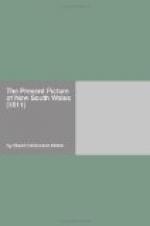The behaviour of the prisoners has recently been much less exceptionable than in the earlier days of the settlement, and they seem to have accommodated their dispositions, in a great degree, to their new situations; those who are guilty of theft have latterly been transported to some remote settlement, and this system of punishment has been found more efficacious than the infliction of castigation, or any other corporal punishment, since they feel an unconquerable repugnance to the idea of a separation from their old connections and companions, and a removal to a solitary scene, where they cannot hope for any opportunities of re-commencing those pursuits which are so truly congenial to their dispositions.
Natives.
Speaking generally of the natives, they are a filthy, disagreeable race of people; nor is it my opinion that any measures which could be adopted would ever make them otherwise. Their wars are as frequent as usual, and are attended with as much cruelty both towards men and women. They are still ready at all times to commit depredations upon the Indian corn, whenever there is a probability of their attempts being attended with the desired success; and this predatory disposition renders it frequently necessary to send detachments of the military to disperse them; but the utmost care is taken to prevent any fatal circumstances from attending these acts of needful hostility, and orders are uniformly issued never to fire upon the natives, unless any particularly irritating act should render such a measure expedient. They are amazingly expert at throwing the spear, and will launch it with unerring aim to a distance of thirty to sixty yards. I myself have seen a lad hurl his spear at a hawk-eagle (a bird which, with wings expanded, measures from seven to ten feet), flying in the air, with such velocity and correctness as to pierce his object, and bring the feathered victim to the earth. This circumstance will tend to shew how soon the youth of these tribes are trained to the use of the spear, and the dexterity to which they attain in this art before they reach the age of manhood. Indeed, instances are by no means uncommon, where an army of natives is seen following a youthful leader of fifteen or sixteen years of age, and obeying his directions implicitly, because his previous conduct had been characterized by remarkable vigour of body, and intrepidity of mind—virtues which qualify natives of every age and rank for the highest honours and the most marked distinctions amongst these untutored sons of nature. Their attachment to savage life is unconquerable; nor can the strongest allurements tempt them to exchange their wild residences in the recesses of the country, for the comforts of European life. A singular instance of this fact occurred in the case of Be-ne-long, who was brought to England by Governor Phillip, and returned with Governor Hunter. For some time after his return, it is true, he assumed the manners, the dress, and the consequence of an




